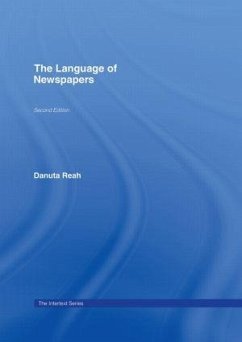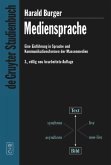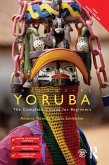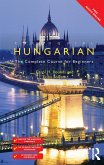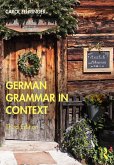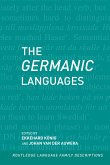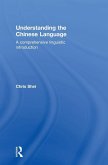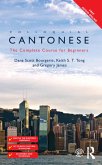Danuta Reah
The Language of Newspapers
Danuta Reah
The Language of Newspapers
- Gebundenes Buch
- Merkliste
- Auf die Merkliste
- Bewerten Bewerten
- Teilen
- Produkt teilen
- Produkterinnerung
- Produkterinnerung
From the ideological bias of the press, to the role of headlines in newspaper articles and ways in which newspapers relate to their audience, the book provides a comprehensive analysis of newspaper language.
Andere Kunden interessierten sich auch für
![Mediensprache Mediensprache]() Harald BurgerMediensprache29,95 €
Harald BurgerMediensprache29,95 €![Colloquial Yoruba Colloquial Yoruba]() Antonia Yetunde Folarin SchleicherColloquial Yoruba167,99 €
Antonia Yetunde Folarin SchleicherColloquial Yoruba167,99 €![Colloquial Hungarian Colloquial Hungarian]() Carol RoundsColloquial Hungarian167,99 €
Carol RoundsColloquial Hungarian167,99 €![German Grammar in Context German Grammar in Context]() Carol FehringerGerman Grammar in Context185,99 €
Carol FehringerGerman Grammar in Context185,99 €![The Germanic Languages The Germanic Languages]() Ekkehard KonigThe Germanic Languages506,99 €
Ekkehard KonigThe Germanic Languages506,99 €![Understanding the Chinese Language Understanding the Chinese Language]() Chris SheiUnderstanding the Chinese Language191,99 €
Chris SheiUnderstanding the Chinese Language191,99 €![Colloquial Cantonese Colloquial Cantonese]() Dana Scott BourgerieColloquial Cantonese168,99 €
Dana Scott BourgerieColloquial Cantonese168,99 €-
-
-
From the ideological bias of the press, to the role of headlines in newspaper articles and ways in which newspapers relate to their audience, the book provides a comprehensive analysis of newspaper language.
Produktdetails
- Produktdetails
- Verlag: Routledge
- 2. Auflage
- Seitenzahl: 140
- Erscheinungstermin: 16. Mai 2002
- Englisch
- Abmessung: 250mm x 175mm x 12mm
- Gewicht: 434g
- ISBN-13: 9780415278041
- ISBN-10: 041527804X
- Artikelnr.: 22219323
- Herstellerkennzeichnung
- Libri GmbH
- Europaallee 1
- 36244 Bad Hersfeld
- gpsr@libri.de
- Verlag: Routledge
- 2. Auflage
- Seitenzahl: 140
- Erscheinungstermin: 16. Mai 2002
- Englisch
- Abmessung: 250mm x 175mm x 12mm
- Gewicht: 434g
- ISBN-13: 9780415278041
- ISBN-10: 041527804X
- Artikelnr.: 22219323
- Herstellerkennzeichnung
- Libri GmbH
- Europaallee 1
- 36244 Bad Hersfeld
- gpsr@libri.de
Danuta Reah is co-author of Working with Texts and a freelance writer and teacher.
Unit one: Introduction
What is a newspaper?
What is news?
Do newspapers contain news?
Who owns the press?
Who pays for newspapers?
Should newspapers be impartial?
Unit two: Headlines
What is a headline?
What are headlines for?
The language of headlines
Putting words in: what the headline writer includes
Taking words out: what the headline writer omits
Shaking it all about: how the headline writer reorganises language
Graphological features of headlines
Headlines as information
Headlines as opinion manipulators
Unit three: Audience
Who reads the papers? How newspapers identify their audience
The identity of the reader
The role of the audience
Editorialising
Unit four: Representation of groups: words, words, words
Linguistic determinism
What's in a name?
Naming of groups
Representations of women
Ethnic group
Unit five: Making Monsters: syntax
Making monsters: Mary Bell, Jon Venables and Robert Thompson
Deleting the actor
Mary Bell
Facts and possibilities
Deleting the action
Modality
Unit six: Discourse
The barbarian at the gates: Britain under siege
Identifying patterns in text
Lexical cohesion
Grammatical cohesion
Pragmatics: language in context
Presupposition
Implicature.
What is a newspaper?
What is news?
Do newspapers contain news?
Who owns the press?
Who pays for newspapers?
Should newspapers be impartial?
Unit two: Headlines
What is a headline?
What are headlines for?
The language of headlines
Putting words in: what the headline writer includes
Taking words out: what the headline writer omits
Shaking it all about: how the headline writer reorganises language
Graphological features of headlines
Headlines as information
Headlines as opinion manipulators
Unit three: Audience
Who reads the papers? How newspapers identify their audience
The identity of the reader
The role of the audience
Editorialising
Unit four: Representation of groups: words, words, words
Linguistic determinism
What's in a name?
Naming of groups
Representations of women
Ethnic group
Unit five: Making Monsters: syntax
Making monsters: Mary Bell, Jon Venables and Robert Thompson
Deleting the actor
Mary Bell
Facts and possibilities
Deleting the action
Modality
Unit six: Discourse
The barbarian at the gates: Britain under siege
Identifying patterns in text
Lexical cohesion
Grammatical cohesion
Pragmatics: language in context
Presupposition
Implicature.
Unit one: Introduction; What is a newspaper?; What is news?; Do newspapers contain news?; Who owns the press?; Who pays for newspapers?; Should newspapers be impartial?; Unit two: Headlines; What is a headline?; What are headlines for?; The language of headlines; Putting words in: what the headline writer includes; Taking words out: what the headline writer omits; Shaking it all about: how the headline writer reorganises language ; Graphological features of headlines; Headlines as information; Headlines as opinion manipulators; Unit three: Audience; Who reads the papers? How newspapers identify their audience; The identity of the reader; The role of the audience; Editorialising; Unit four: Representation of groups: words, words, words; Linguistic determinism; What's in a name?; Naming of groups; Representations of women; Ethnic group; Unit five: Making Monsters: syntax; Making monsters: Mary Bell, Jon Venables and Robert Thompson; Deleting the actor; Mary Bell; Facts and possibilities; Deleting the action; Modality; Unit six: Discourse; The barbarian at the gates: Britain under siege; Identifying patterns in text; Lexical cohesion; Grammatical cohesion; Pragmatics: language in context; Presupposition; Implicature.
Unit one: Introduction
What is a newspaper?
What is news?
Do newspapers contain news?
Who owns the press?
Who pays for newspapers?
Should newspapers be impartial?
Unit two: Headlines
What is a headline?
What are headlines for?
The language of headlines
Putting words in: what the headline writer includes
Taking words out: what the headline writer omits
Shaking it all about: how the headline writer reorganises language
Graphological features of headlines
Headlines as information
Headlines as opinion manipulators
Unit three: Audience
Who reads the papers? How newspapers identify their audience
The identity of the reader
The role of the audience
Editorialising
Unit four: Representation of groups: words, words, words
Linguistic determinism
What's in a name?
Naming of groups
Representations of women
Ethnic group
Unit five: Making Monsters: syntax
Making monsters: Mary Bell, Jon Venables and Robert Thompson
Deleting the actor
Mary Bell
Facts and possibilities
Deleting the action
Modality
Unit six: Discourse
The barbarian at the gates: Britain under siege
Identifying patterns in text
Lexical cohesion
Grammatical cohesion
Pragmatics: language in context
Presupposition
Implicature.
What is a newspaper?
What is news?
Do newspapers contain news?
Who owns the press?
Who pays for newspapers?
Should newspapers be impartial?
Unit two: Headlines
What is a headline?
What are headlines for?
The language of headlines
Putting words in: what the headline writer includes
Taking words out: what the headline writer omits
Shaking it all about: how the headline writer reorganises language
Graphological features of headlines
Headlines as information
Headlines as opinion manipulators
Unit three: Audience
Who reads the papers? How newspapers identify their audience
The identity of the reader
The role of the audience
Editorialising
Unit four: Representation of groups: words, words, words
Linguistic determinism
What's in a name?
Naming of groups
Representations of women
Ethnic group
Unit five: Making Monsters: syntax
Making monsters: Mary Bell, Jon Venables and Robert Thompson
Deleting the actor
Mary Bell
Facts and possibilities
Deleting the action
Modality
Unit six: Discourse
The barbarian at the gates: Britain under siege
Identifying patterns in text
Lexical cohesion
Grammatical cohesion
Pragmatics: language in context
Presupposition
Implicature.
Unit one: Introduction; What is a newspaper?; What is news?; Do newspapers contain news?; Who owns the press?; Who pays for newspapers?; Should newspapers be impartial?; Unit two: Headlines; What is a headline?; What are headlines for?; The language of headlines; Putting words in: what the headline writer includes; Taking words out: what the headline writer omits; Shaking it all about: how the headline writer reorganises language ; Graphological features of headlines; Headlines as information; Headlines as opinion manipulators; Unit three: Audience; Who reads the papers? How newspapers identify their audience; The identity of the reader; The role of the audience; Editorialising; Unit four: Representation of groups: words, words, words; Linguistic determinism; What's in a name?; Naming of groups; Representations of women; Ethnic group; Unit five: Making Monsters: syntax; Making monsters: Mary Bell, Jon Venables and Robert Thompson; Deleting the actor; Mary Bell; Facts and possibilities; Deleting the action; Modality; Unit six: Discourse; The barbarian at the gates: Britain under siege; Identifying patterns in text; Lexical cohesion; Grammatical cohesion; Pragmatics: language in context; Presupposition; Implicature.

